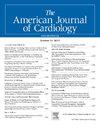根据st段抬高时间分层的临床特征和结果:STEMI患者的晚期表现。
IF 2.3
3区 医学
Q2 CARDIAC & CARDIOVASCULAR SYSTEMS
引用次数: 0
摘要
关于st段抬高型心肌梗死(STEMI)患者的临床特征的资料很少,这些患者出现较晚(从症状开始到到达医院的时间较长)。在SAGA-ACS登记的719例连续接受经皮冠状动脉介入治疗(PCI)的STEMI患者中,我们比较了早期出现(症状发作至就诊时间)患者的基线特征和临床结果本文章由计算机程序翻译,如有差异,请以英文原文为准。
Clinical Characteristics and Outcomes Stratified by Time to ST-Segment Elevation Myocardial Infarction Presentation
There were few data on the clinical characteristics of ST-segment elevation myocardial infarction (STEMI) patients with late presentation (long symptom onset to door [hospital arrival] time). Among 719 consecutive patients with STEMI who underwent percutaneous coronary intervention (PCI) in the SAGA-ACS registry, we compared baseline characteristics and clinical outcomes between patients with early presentation (symptom onset to door time <2.3 hours) and late presentation (≥2.3 hours). The cut-off point of 2.3 hours was the median value for the present study population. The median onset to door time was 1.3 hours in the early presentation group, and 4.8 hours in the late presentation group. Door to balloon time was not different between the groups (62.0 minutes vs 60.5 minutes). Late night to early morning onset (OR, 2.03; 95% CI, 1.45 to 2.85), age ≥75 years (OR, 1.56; 95% CI, 1.09 to 2.22), and women (OR, 1.49; 95% CI, 1.03 to 2.16) were independently associated with the late presentation, while culprit lesions in right coronary artery (RCA) was inversely associated the late presentation (OR, 0.62; 95% CI, 0.46 to 0.85). During the median 2.7 years follow-up, the cumulative incidence of all-cause death was numerically, but not statistically, higher in the late presentation group than in the early presentation group (16.3% vs 11.6% at 3 years, HR, 1.42; 95% CI, 0.97 to 2.07; p = 0.07). In conclusion, among patients with STEMI who underwent PCI, late night to early morning onset, advanced age, women, and culprit lesions in non-RCA were strongly associated with the late presentation. Strategies for minimizing symptom onset to door time should be targeted especially in these patients.
求助全文
通过发布文献求助,成功后即可免费获取论文全文。
去求助
来源期刊

American Journal of Cardiology
医学-心血管系统
CiteScore
4.00
自引率
3.60%
发文量
698
审稿时长
33 days
期刊介绍:
Published 24 times a year, The American Journal of Cardiology® is an independent journal designed for cardiovascular disease specialists and internists with a subspecialty in cardiology throughout the world. AJC is an independent, scientific, peer-reviewed journal of original articles that focus on the practical, clinical approach to the diagnosis and treatment of cardiovascular disease. AJC has one of the fastest acceptance to publication times in Cardiology. Features report on systemic hypertension, methodology, drugs, pacing, arrhythmia, preventive cardiology, congestive heart failure, valvular heart disease, congenital heart disease, and cardiomyopathy. Also included are editorials, readers'' comments, and symposia.
 求助内容:
求助内容: 应助结果提醒方式:
应助结果提醒方式:


